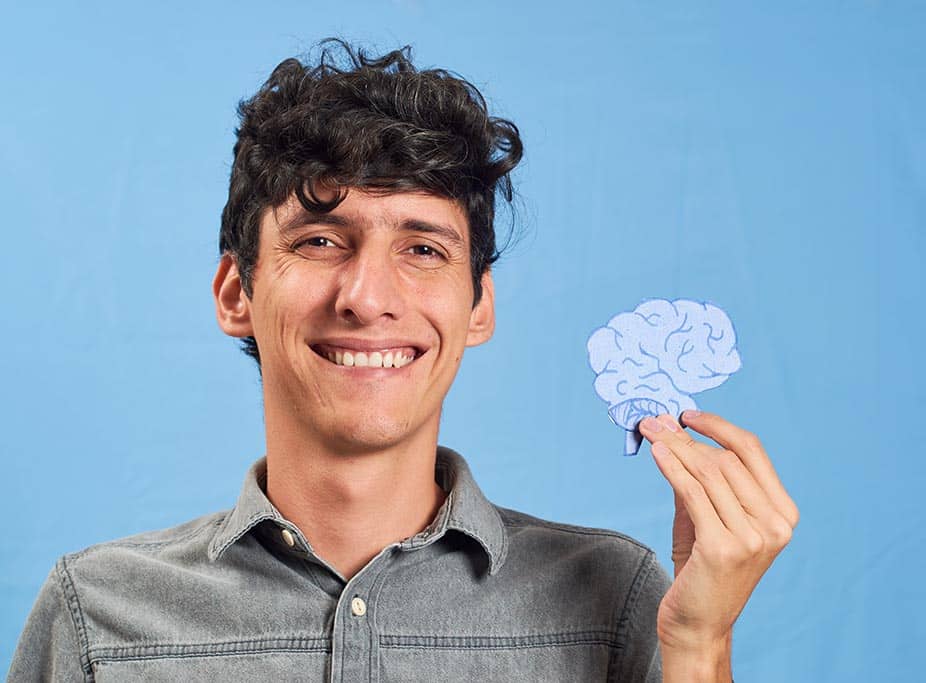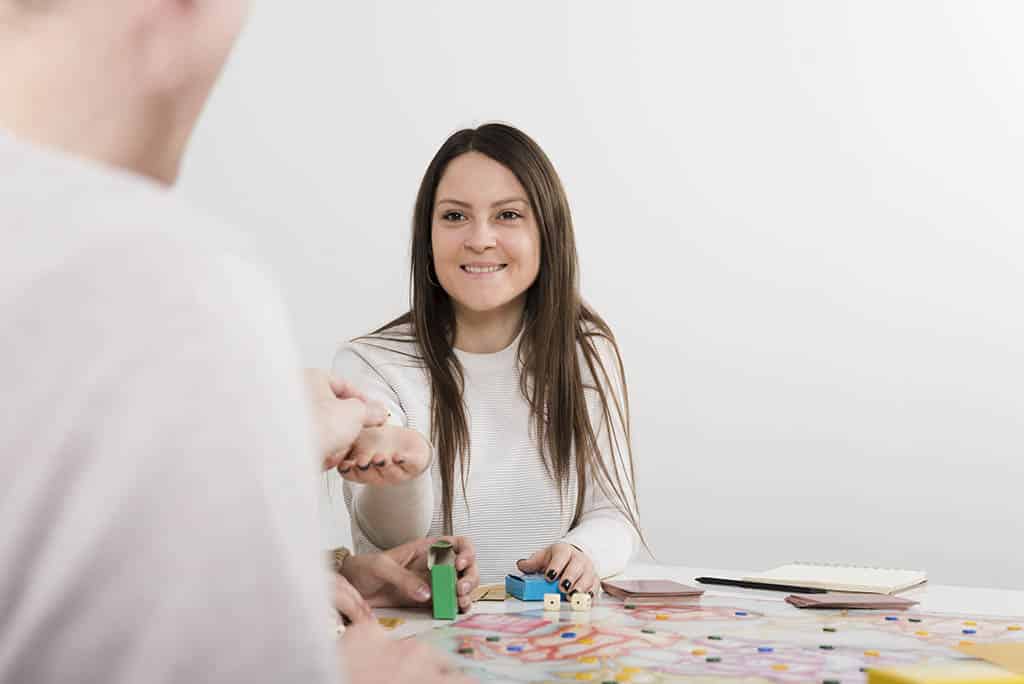COGNITIVE BEHAVIORAL THERAPY IN PALATINE, IL
At New Transitions Counseling Center, we genuinely believe in your ability to change. Many people who visit our therapists feel stuck. They keep repeating the same patterns again and again, and feel paralyzed when they try to break the cycle. They are consumed with their insecurities, feelings of worthlessness, and preconceived notions about the world. We’re here to tell you that you don’t have to be controlled by your thoughts. With cognitive behavioral therapy (CBT), you can challenge the thoughts and behaviors that are holding you back.

WHAT IS COGNITIVE BEHAVIORAL THERAPY?
Cognitive behavioral therapy is a therapeutic approach that has been shown as an effective treatment for depression, anxiety disorders, and other mental health conditions. CBT is one of the most heavily researched types of therapy, and study after study have found it equally as effective, if not more effective, than many other mental health treatments. In fact, CBT stands out from the crowd in that there is an abundance of empirical scientific evidence that it produces long-term change for people who struggle with mental illness.
Cognitive behavioral therapy is based on the idea that many psychological challenges are partly due to unhelpful patterns of thinking and behavior. The focus of CBT treatment is teaching people with mental illness to challenge these unhelpful patterns, making it easier to cope with their condition. The idea is that, while we can’t change our circumstances when difficult situations come up, we can change the way we react to them.
A BRIEF HISTORY OF CBT
Cognitive behavioral therapy was first introduced in the 1960s by Dr. Aaron Beck, a psychiatrist. While providing psychoanalysis, Dr. Beck conducted experiments aiming to validate the therapeutic concepts of depression that were common at the time. To his surprise, his findings were quite the opposite, spurring him to look for other ways to conceptualize depression. He began noticing that his patients would have spontaneous negative thoughts, which he referred to as “automatic thoughts.” These cognitions would reflect negative ideas about themselves, the future, or the world (which he would later coin “the cognitive triad”). With this in mind, Dr. Beck began teaching his patients to identify these thoughts and to replace them with more realistic ones. This helped them feel and function better in their daily lives long-term. Since Dr. Beck’s initial discoveries, which he coined as “cognitive therapy,” CBT has evolved to become an umbrella term for different types of therapy that share these principles. Thousands of studies have now been conducted on CBT since its inception, and today, it is one of the most popular therapeutic approaches.


HOW COGNITIVE BEHAVIORAL THERAPY WORKS
One of the benefits of cognitive behavioral therapy is that it is generally short-term. Most of the time, issues can be resolved through weekly sessions for between five and 10 months. During your CBT therapy session, your therapist will work with you to identify problematic beliefs, attitudes, thoughts, and behaviors that are contributing to your suffering, and help you develop the skills to cope. The key to CBT is clearly identifying your problem and creating goals around the issue. Your therapist will likely give you homework to do outside of your session to help you practice using tools to help challenge your thoughts and change your behavior. In addition, CBT is most effective when you work with a therapist with whom you feel comfortable. Your therapist should be empathetic and make you feel understood and validated, while still challenging the preconceived notions that are preventing you from healing.
WHY COGNITIVE BEHAVIORAL THERAPY WORKS
Cognitive behavioral therapy provides certain unique advantages over other therapeutic approaches, which is why it is so effective. First of all, CBT programs are designed to be structured and actionable. This systematic approach is similar to learning any skill — practice makes perfect. For example, if you come in for depression therapy, your therapist might have you journal daily about your upset thoughts, then bring your journal to therapy so together, you can determine how realistic those thoughts are. By consistently practicing this healthful way of thinking, it makes it easier to instinctive do it over time.
In addition, cognitive behavioral therapy is that not only has it already been studied extensively, the structured nature of it makes it easy to study. We can easily test any therapy programs and find out what works and what doesn’t so we can pivot your treatment to be as successful as science tells us it will be.

CBT also is effective because it is repetitive. Many of the things you talk about with your therapist are probably things you already know. You know intellectually that getting drunk every night is not helping your problems, but it’s how you know to cope with the overwhelming thoughts that cloud your mind. During CBT, your therapist helps by pointing out the repeated thoughts you have that lead you to drink, and helping you develop other coping techniques for these thoughts over time. By continually challenging unhelpful thoughts and behaviors and regularly introducing new coping mechanisms, CBT uses the proven benefits of repetition for adopting new habits.
Finally, cognitive behavioral therapy is collaborative. You won’t be sitting there, listening to a lecture from your therapist about how you should feel or what you should do. CBT is a team effort where both you and your therapist need to put in equal effort to get results. Together, you will identify what you can do in your daily life to feel better.

WHAT TO EXPECT FROM COGNITIVE BEHAVIORAL THERAPY
When you come in for cognitive behavioral therapy, you can expect to commit to weekly sessions at our center here in Palatine, most likely for a set period of time that you and your therapist establish. The first few sessions will be aimed at identifying where you want to focus and making sure that CBT is the right treatment for your needs. Your therapist will want to get to know more about you, your background, and what your life is like. With more information about you, if CBT seems to be the right way to go, your therapist will work with you to talk about what treatment will look like going forward.
Once you have gotten more comfortable in therapy, you and your therapist will determine what problems you want to focus on. Your therapist might ask you to begin keeping a journal so it’s easier to accomplish this. From there, you will begin analyzing your emotions, thoughts, and behaviors to identify any that are unhelpful or unrealistic. You will assess how these things impact you, as well as how you can change them. After you have done this, your therapist will likely give you exercises to utilize in your daily life. For example, they might ask you to identify when you have an unrealistic thought and replace it with a more optimistic one. Other homework you might have to do includes written practice exercises, journaling, or implementing a new self-care measure. Then, during your session, you will talk about what worked and what didn’t and adapt your plans from there.
Change is hard. It can also be very difficult to face some of the thoughts and feelings that come up in therapy. Know that your therapist understands this and will never push you to do things more quickly. They will regularly check in with you to make sure that you are comfortable throughout the process. Therapy is only effective if you feel like it is a safe space for you, so be sure to communicate with your therapist honestly about how you feel about CBT.
COGNITIVE DISTORTIONS
The human brain naturally wants to form connections. The majority of the time, this is helpful for teaching us how to interact with the world. Sometimes, however, we create relationships between things that don’t exist, to our detriment. For example, if you fail at something, your brain may think, “I will never be successful,” which is both unhelpful and not true. When developing cognitive behavioral therapy, Dr. Beck coined the term “cognitive distortions” to refer to the inaccurate thoughts that we use to reinforce negative thoughts and feelings. Cognitive distortions are all irrational and false and may cause us psychological harm. In the 1980s, Dr. David Burns expanded on Dr. Beck’s concept and identified specific, common cognitive distortions, some of which we have outlined below.

Black-and-White Thinking
Black-and-white thinking, also known as all-or-nothing thinking or polarized thinking, is thinking in terms of extremes. There are no shades of gray with black-and-white thinking. You are either perfect or a complete failure; your life is either fantastic or absolutely terrible.

Over Generalization
Jumping to Conclusions
There are a couple of ways this distortion manifests. You may make assumptions about what a person is thinking, why they behave the way they do, and how they feel about you without asking if you are correct. Alternatively, you could try to predict the future, assuming that something won’t work out.
Disqualifying the Positive
When you disqualify the positive, you may acknowledge a positive experience, but reject it. For example, if someone gives you a compliment, you might attribute it to them trying to get on your good side and having nothing to do with your own positive qualities.
Control Fallacies
Control fallacies have two categories: external and internal control. When you feel externally controlled, it means that you feel helpless—you are victim of others or simply of fate. The fallacy of internal control is when you take on responsibility for everyone else’s happiness and pain.
Should Statements
You can recognize this distortion by the words “should, “must,” and “ought.” These are rules for behavior that you adopt for yourself and others. When you don’t live up to these rules, you feel guilty, and when others don’t, you feel angry at them. “Shoulds” cause frustration, resentment, and guilty.
Emotional Reasoning
With emotional reasoning, you believe that because you feel something, it must be true. Whatever unhealthy feeling you have reflects who you are as a person. If you feel stupid, it means that you are stupid.
COMMONLY USED CBT TECHNIQUES
Cognitive behavioral therapy involves a variety of techniques, some that are used in therapy and others that your therapist may ask you to practice outside of your session.
Journaling
It is very common to use journaling for CBT. This is a helpful exercise because it allows you to collect information about your moods and thoughts. Your therapist might ask you to keep a log of notable emotions or thoughts, including when it happened, what caused it, how long it lasted, and how you responded to it. This can help you identify common thought patterns and emotions, and learn how to adapt them to be healthier.

Identifying Cognitive Distortions
This will be done with and without your therapist and will be the main focus of your work in CBT. You want to be able to identify your common cognitive distortions, and challenge them. Journaling is very helpful for this.

Cognitive Restructuring
After identifying your distortions, you want to start understanding where they came from and why you came to adopt them. Once you have determined the source, you can begin to challenge those thoughts and replace them with other, more rational thoughts. For example, you might think that you are worthless because you don’t have a high-paying job. Instead of accepting this thought, you would think about what exactly gives a person worth and why you think it has anything to do with money.
Progressive Muscle Relaxation (PMR)
COGNITIVE BEHAVIORAL THERAPY IN PALATINE
At New Transitions Counseling Center, we specialize in cognitive behavioral therapy for a variety of problems, including anxiety, depression, substance abuse, eating disorders, and relationship issues. Contact us today to start working towards a happier, healthier you.

RECENT POSTS

How To Cope With Anxiety As The World Opens Up
Although the coronavirus is still affecting the world, we are seeing that the world has begun to open

Sheltering In Place Alone: How To Combat Loneliness
Life as we know it has been entirely disrupted by the global pandemic. You may have lost your

Mental Health Tips For Social Distancing
As the COVID-19 pandemic spreads across the country, many people are taking necessary precautions to protect their physical

